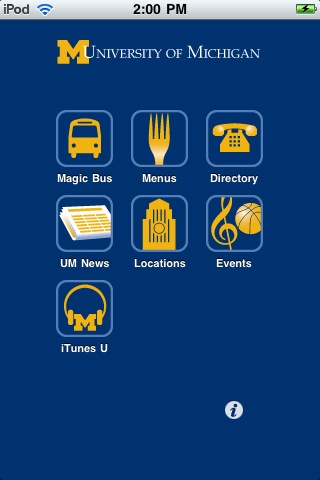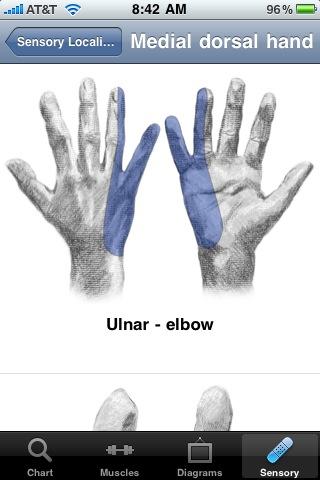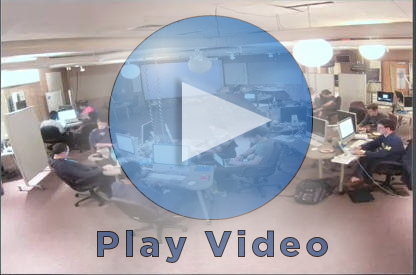Key Takeaways
- The fragmented and evolving nature of the mobile market makes it nearly impossible to develop apps for every platform.
- The University of Michigan mobile team’s strategy is to create a widespread community of mobile developers and leverage the power of crowdsourcing.
- Although upgrading student-built apps for public consumption takes considerable staff time, working directly with students yields incredible insight into how they interact with technology in their daily lives.
- By providing the necessary support for students and staff interested in mobile programming to develop their ideas, U-M has successfully crowdsourced the creation of apps useful to the entire campus community.
The fragmented and evolving nature of the mobile market makes it nearly impossible to develop applications for every platform. Faced with limited budget and staff, the University of Michigan (U-M) mobile team decided initially to develop apps for iOS, Android, and web-based platforms, with the eventual goal of transitioning to only web-based apps. This provided an opportunity to better understand the market’s top players while addressing the reality that our limited resources make supporting code for enterprise apps on multiple platforms unsustainable in the long term.
In January 2010, a team of more than 30 people — who could really only contribute time equivalent to six full-time staff — began its mission to partner with developers across campus, including students, rather than just create apps in isolation. With a total budget of $500,000, the majority going toward personnel and contractor costs, we spent just over $20,000 on devices — Apple MacBooks, iPhones, Androids, an iPad, and iPod Touches — and some training opportunities, such as Agile. The team also accessed the free Stanford lectures on iTunes U about mobile app development for an iOS platform.
Our strategy is to create a widespread community of mobile developers and leverage the power of crowdsourcing. There are many mobile developers across the university, but given the large, decentralized nature of U-M, we recognized the immediate challenge of connecting them and making key resources available to support their creative efforts. We needed to encourage the entrepreneurial spirit of our students, faculty, and staff through collaboration.
In this video, Assistant Dean and Program Sponsor Lynn Johnson discusses the U-M mobile environment:
An Online Resource for Developers
In June 2010, U-M launched its online Mobile Center to better enable collaboration, processes, and standards. This resource makes it easier for developers to locate and connect with university and local mobile interest groups, use the online forum to swap tips for developing on specific platforms, share job opportunities, or offer advice on getting started.
The Mobile Center also features a developer toolkit containing guidelines on:
- Licensing and distribution
- Design and usability
- University logo and identity usage
- Accessibility
Making sure that as many people as possible can access and interact with U-M’s apps, regardless of disability or restrictions of their browsing environment, is an essential consideration. We partner with the U-M Office of Institutional Equity to ensure that apps are accessible.
In this video, Web Accessibility and Adaptive Technology Coordinator Scott Williams discusses advances in accessibility and demos the accessibility features of VoiceOver on an iPad using the U-M app:
We are also developing APIs for use by developers of mobile and non-mobile apps. Scheduled for release later this year, the API directory will allow developers to combine local data with the university’s enterprise data.
Unleashing Innovation Inside (and Outside) the Classroom
The U-M mobile team is building strong relationships with faculty and students through U-M programs that also encourage mobile innovation. Students’ desire to do something with mobile is rapidly increasing on campus. U-M’s Mobile and Web App Programming class has doubled its size, from 40 to nearly 80 students, in just two years due to growing demand.
U-M students can also participate in the 48-Hour Mobile Apps Hackathon, a faculty-sponsored event that offers a completely distraction-free environment, providing the time, space, food, caffeine, and camaraderie students need to build an app from the ground up.
In this video, U-M students with an interest in mobile device programming gather for the third Smartphonia Mania Hackathon:
The U-M Mobile Apps Challenge, a biannual contest sponsored by our team, the U-M Office of Technology Transfer; U-M Electrical Engineering and Computer Science; Apple, Inc. and Google, offers awards for the most creative and innovative app solutions. To date, this contest has attracted nearly 50 entries from doctors, faculty members, staff, and students. Winning apps so far:
- Help people manage their frequent-shopper cards
- Build playlists while listening to music
- Find friends though location-based social networking
We partner with the Office of Tech Transfer to acquire licensing for purchasing and releasing apps. Tech Transfer advises our mobile team on university policies, provides connections within the university business engagement center, and serves as part of a cross-campus governance group.
Leveraging Campus Creativity
The strategy to collaborate rather than to build all on our own is paying off — for students, the university, and all mobile device aficionados. By tapping into the expertise that thrives on campus, we are working toward building a catalog of free apps despite our limited resources.
In this video, Engineering Lecturer Jeff Ringenberg explains how mobile opportunities benefit both students and the university as a whole:
What began as a class project for two former U-M computer science and engineering students became U-M’s first official app. Kevin Chan and Mark Yang developed the initial version of the Michigan app for the Mobile and Web App Programming course in winter 2009. In March 2010, U-M purchased the app from Chan and Yang, added some additional features and security, and scaled it for broader use. Released through the iTunes store in June 2010, the Michigan app (Figure 1) has since been downloaded more than 19,400 times. With just a few taps on an iPhone, iPad, or iPod, anyone can now read university news, navigate the U-M campus, track campus buses in real time, or even play the U-M fight song.

Figure 1. The Michigan App
Purchasing student-built apps can require considerable staff time and resources to ensure the apps are scalable and comply with university security and policies. Our team worked on the Michigan app full time for three months before releasing it for public consumption. Nevertheless, working directly with students gives us incredible insight into how they interact with technology in their daily lives. We are currently reviewing other student-built apps for potential university purchase.
U-M faculty and staff also play a large role in this space. One of the more unique apps, Nerve Whiz (Figure 2), is a free application for medical professionals interested in learning the complex anatomy of nerve roots, plexuses, and peripheral nerves. The app was created by a neuromuscular neurologist at U-M.

Figure 2. Image from the Nerve Whiz App
In March 2011, the U-M mobile team unveiled its Student Academics app, which provides a schedule of classes and other useful tools for managing academic life at U-M.
Upcoming mobile team–created apps, scheduled for release in 2011, will serve a campus-wide audience:
- MFile: a secure way to access institution-hosted files from a mobile device
- MPrint: additional functionality built into MFile to enable mobile device printing to campus printers
- Single Sign-On (SSO): a type of authentication, which developers can apply to allow users to sign in via the Weblogin service and securely access protected services via other mobile apps
Crowdsourcing Works
Mobile technology is changing the world more quickly and profoundly than any other innovation before it. Keeping current with limited resources poses a challenge we expect to live with for a long time. Nevertheless, using a crowdsourcing approach at U-M is already paying off in unexpected ways. We have seen clear benefits from:
- Partnering with a wider range of programming talent
- Gaining unique insights into our campus customers’ needs
- Expanding support for mobile innovation across the university
- Ensuring we deliver relevant apps that met the needs of U-M students, faculty, and staff
By providing the necessary support for students and staff interested in mobile programming to develop their ideas, U-M has successfully crowdsourced the creation of apps useful to the entire campus community. We plan to continue building this community-wide approach to app development at U-M.
Acknowledgments
Special thanks for contributions to this article and production of the video clips goes to Heather Hengesbach, marketing communications specialist for the mobile team, and Michael Stork, videographer.
© 2011 Cassandra Carson. The text of this EQ article is licensed under the Creative Commons Attribution-Noncommercial-Share Alike 3.0 license.

